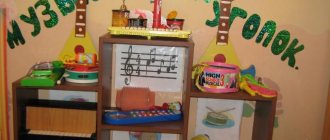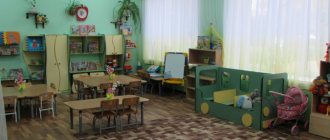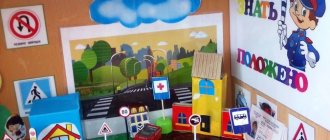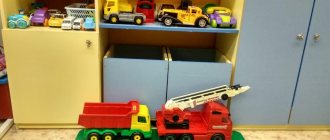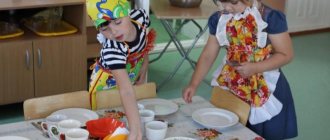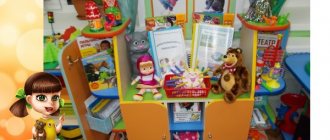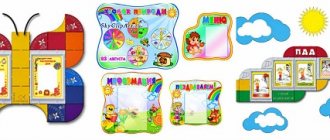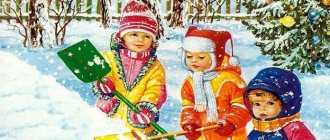Construction of a subject-developmental environment in the preparatory group in accordance with the Federal State Educational Standard
The direction of a child’s activity and development depends on us, adults - on how the subject-spatial organization of their life is structured, what toys and teaching aids it consists of, what their developmental potential is, and even on how they are located.
Everything that surrounds a child shapes his psyche and is the source of his knowledge and social experience. Therefore, it is we, adults, who take upon ourselves the responsibility to create conditions that contribute to the full realization of the development of children, their capabilities, abilities in all psychophysiological parameters, i.e. the organization of a subject-spatial developmental environment. We, teachers, sought to create conditions in the group for joint activity of children and adults, for independent activity of pupils, taking into account the developmental characteristics of each child. When organizing a developmental subject-spatial environment for children in the group, several options for its construction were used:
1. Zoning of space is carried out using mobile means - arranging furniture and equipment.
2. Use of bedroom premises.
3. One of the main factors determining the possibility of implementing the principle of activity is the creation of a play environment that provides the child with the opportunity to move.
The subject-spatial development environment is organized taking into account the requirements of the Federal State Educational Standard, where all five educational areas are clearly visible:
1) social and communicative,
2) educational,
3) speech,
4) artistic and aesthetic,
5) physical.
When constructing a subject-spatial development environment, the following principles were taken into account:
1. the principle of distance, position during interaction;
2. the principle of activity, independence, creativity;
3. principle of stability, dynamism;
4. principle of integration and flexible zoning;
5. the principle of emotionality of the environment, individual comfort and emotional well-being of each child and adult;
6. the principle of combining conventional and extraordinary elements in the aesthetic organization of the environment;
7. principle of openness - closedness;
8. the principle of taking into account gender and age differences in children.
Activity centers are organized based on the integration of content and activities in the following areas.
Direction: Artistic and aesthetic development.
For the development of children, various pictures, drawings depicting crafts, design options for products, diagrams depicting the sequence of work for making various crafts, etc. have been selected. This gives children new ideas for their productive activities, and also involves mastering the ability to work according to a model . This center contains materials and equipment for artistic and creative activities: drawing, modeling and applications (paper, cardboard, stencils, paints, brushes, glue, pencils, napkins, scissors, coloring books, clay, plasticine, educational games, etc. ). Most of the listed materials are placed in a specially designated cabinet. If desired, the child can find and use what is necessary to realize his creative ideas, plans, and fantasies. This center has free access.
Direction: Speech development.
includes a book corner. The content of the book corner corresponds to the age characteristics of children of this age and the educational program implemented in the preschool institution. It contains books with works of fiction by children's writers, fairy tales and other literary forms on the topic of the week. The main principle of selecting book publishing products is a minimum of text - a maximum of illustrations. In the book corner there is a photograph of the writer whose work children are currently becoming familiar with and his literary works.
There are various didactic games for speech development, a series of pictures and illustrations to establish the sequence of events, sets of paired pictures for correlation, sectional plot pictures, etc. A speech development environment is a specially organized environment that most effectively influences the development of various aspects speech of every child.
Direction: Cognitive development.
The centers are organized and presented taking into account the individual characteristics of children, their sensory experience, information baggage, i.e. theoretical and conceptual awareness of the child. Selected visual didactic material gives children an idea of a holistic picture of the world, the close relationships and interactions of all objects.
includes environmental activities. This center contains various types of indoor plants, on which it is convenient to demonstrate modifications of plant parts, tools for caring for these plants: aprons and sleeves, sticks for loosening, metal children's rakes and shovels, a spray bottle, watering cans, etc. Passports are issued for all plants with symbols. During the cold season, my children and I place an indoor mini-vegetable garden here. In addition to indoor plants, this center contains various didactic games of an environmental orientation, a series of paintings such as “Seasons”, “Animal and Plant World”, collections of natural materials, dummies of vegetables and fruits, insects, etc. An important component of the corner of nature is a calendar nature and weather. Designed layouts (desert, north pole, tropics, layouts of prehistoric life (dinosaurs) and landscape layout). All components of the layout are mobile, i.e. in storage mode it consists of a panel and a box of materials. Children, at their own discretion, fill the layout with content with various plant elements and small architectural forms. Working with layouts contributes to the development of creative thinking and the development of landscape design skills.
Our little “why girls” will turn into inquisitive testers, conduct simple experiments, and determine the properties of various natural materials.
The center for experimental activities is represented by a variety of collections (soil, stones, minerals, seeds, cereals, etc.). It contains material for carrying out experimental activities: magnifying glasses, microscopes, compasses, beakers, flasks, measuring cups, watering cans, watches, etc. In the process of experimental activities on growing plants, observation diaries are kept in which the teacher records the conclusions made by the children on results of daily observation. Our little “why girls” will turn into inquisitive testers, conduct simple experiments, and determine the properties of various natural materials.
(toy library) has important developmental functions. In this center there are normative and symbolic materials: a magnetic board, sets of cards for comparing numbers and quantities, sets of cubes with numbers and numerical figures, various types of mosaics and modern puzzles are presented. A fairly wide selection of games to develop fine motor skills. When choosing games, preference was given to the games' ability to stimulate children's development. Such games are educational games by Voskobovich, “Mongolian Games”, Cuisenaire Sticks, Nikitin’s “Cut Square”, “Dyenesh Logic Blocks”, etc. Game equipment creates a rich, holistic environment with sufficient space for games. The center solves the following tasks:
- purposeful formation in children of interest in elementary mathematical activities.
- instilling in children the need to occupy their free time not only with interesting games, but also with games that require mental stress and intellectual effort.
This center contains a variety of entertaining material so that each child can choose a game according to their interests.
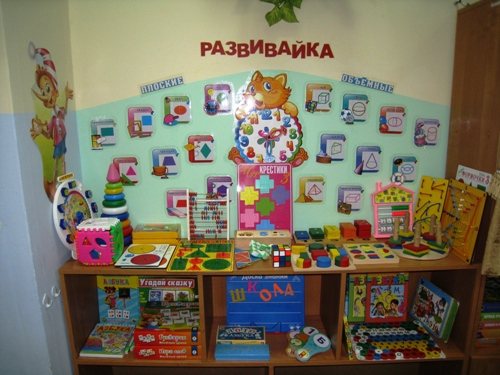
The “Moral and Patriotic” Center houses the state symbols of the native city, the Ivanovo region and Russia. It contains manuals reflecting the multinationality of our Motherland, illustrative material to familiarize children with the climatic zones of Russia, samples of folk arts and crafts, etc. A corner of their native land has been designed, in which children can get acquainted with the traditions, culture and way of life of the inhabitants of the Ivanovo province . The corner of the native land includes fiction on local history, the album “My City”, “My Family”, “The History of Calico”, etc.
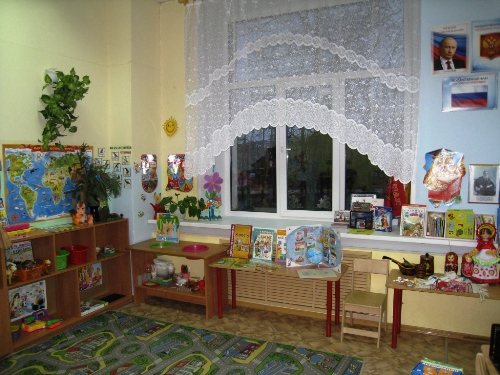
The “Construction” (constructive) Center, although concentrated in one place and takes up little space, is quite mobile. Its practicality lies in the fact that with the contents of the construction corner (various types of construction sets, large and small wooden construction sets), you can move to any place in the group and organize this activity both with a subgroup of children and individually. In the group there is a center for construction games, in which various types and forms of construction sets are presented in a wide variety. Our students independently use diagrams and models of buildings to realize their plans. The center is supplemented with small toys for playing with. The mobility of this center allows children to develop the plot of the game outside of it. This allows our children to feel comfortable in any corner of the group.
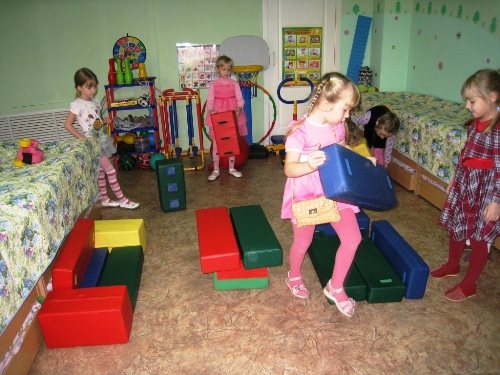
The “Musical and Theatrical” Center is an important object of the developmental environment, since it is the theatrical activities that help to unite the group and unite children with an interesting idea. In the theater, preschoolers open up, demonstrating unexpected facets of their character. There are screens and various types of theaters located here. Children are great artists, so they happily participate in productions and happily act as spectators. It is represented by various types of theaters (puppet, shadow, tabletop, bibabo, finger). Here there are masks, attributes for acting out fairy tales, elements of costumes for the characters, and the children make their own decorations. The musical development of a child comes down not only to classes with a teacher, but also to the opportunity to play independently, improvise, and play music freely. For this purpose, our group has created a musical one. Which helps my students transfer the experience gained in music classes to other conditions, helps to establish a sense of self-confidence, activity, and initiative.
There is a TV, a laptop, a DVD player, a tape recorder, a microphone, a collection of discs and recordings with music and fairy tales. The laptop is used to play videos, illustrations and presentations on TV, and also as an interactive trainer for individual lessons with children. Also in the center there are children's musical instruments (spoons, rattles, tambourines, drums, etc.), which are used by children in free activities.
To optimize children's physical activity, we use sleeping quarters while children are awake. According to SanPiN, the use of three-tier beds is allowed, thereby creating additional space for children to play outdoors. In the bedroom there is a fitness center and themed play corners for organizing children's story games. In these corners, play equipment and toys are arranged accordingly, which tells children the plot of the game and how to implement it, allows them to develop children’s initiative and motor activity, and makes it possible for the individual development of the child’s basic types of movements.
Direction: Social and personal development.
Children are developing the foundations of a culture of communication, consolidating knowledge about the surrounding reality and life in society, through solving problem situations through play, theatrical activities, and life safety.
The equipment and aids are placed in such a way that children can easily select toys and combine them “to suit their creative play ideas.” Due to the fact that the play plans of older preschoolers are very diverse, all stationary play furniture is used multifunctionally for various role-playing games. The gaming material is placed in boxes with symbols, the children choose the plot of the future game at their own discretion, and transfer the gaming material to a place convenient for them, for free construction of the playing space. Universal play layouts are located in places easily accessible to children. The models are portable (to play on the table, on the floor, in any place convenient for the child). Thematic sets of small character figures are placed in boxes, close to the layouts (so that the universal layout can be easily and quickly “populated”, at the request of the players).
reflects safety at home, on the street (traffic rules) and fire safety. It is equipped with the necessary attributes, toys, and educational games. A good teaching aid is a specially equipped table with street and road markings, and an additional set of small building materials and road signs. I think that creating a safety center in a group helps children become familiar with the rules and norms of safe behavior and develop the values of a healthy lifestyle.
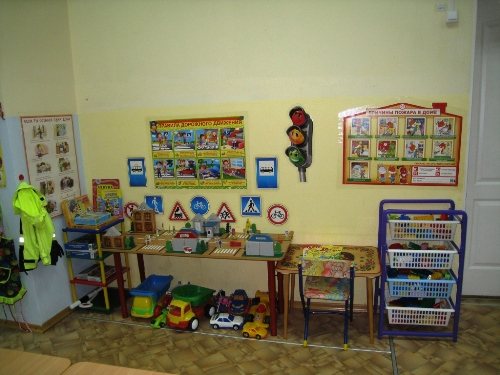
Direction: Physical development.
contains both traditional physical education equipment and non-traditional (non-standard) equipment made by the hands of teachers and parents. This equipment is aimed at developing the physical qualities of children - agility, accuracy, eye, reaction speed, strength qualities. At the present stage of development, there is a need to place games and manuals in this center to introduce older preschoolers to healthy lifestyle skills. This Center is popular among children because it fulfills their need for physical activity. An increase in physical activity has a beneficial effect on the physical and mental development and health of children.
In the noisy space of the playroom there must be an island of peace and quiet. There is also a “Privacy Corner” in the bedroom. If a child is tired of noise and wants to be in silence, he can go to a corner of solitude and relaxation. This is a cozy, quiet place, near an artificial palm tree. Soft pillows with various animals to which a child can tell his secrets and experiences. Musical recordings with birdsong, the murmur of a river, the noise of a forest - all this has a beneficial effect on the emotional state of children.
English writer Oscar Wilde said that “The best way to make children good is to make them happy...”. And all our children are good! And by creating a favorable development environment for our children, we want to see them also like this: mastering the basic cultural ways of activity, possessing a positive attitude towards the world, a developed imagination, able to express their thoughts, curious, resilient and physically developed, and most importantly, happy! The advantage of the created environment is that it is possible to involve all children in active independent activities. Each child chooses an activity of interest in any center, which is ensured by a variety of subject content, accessibility and ease of placement of materials. It was noted that pupils have less conflict with each other: they rarely quarrel over games, play space or materials, because they are passionate about interesting activities. The positive emotional attitude of my children testifies to their cheerfulness, openness, and desire to attend kindergarten.
The search for innovative approaches to organizing a subject-development environment continues, the main criteria being creativity, talent and imagination.
Authors: Leontyeva Tatyana Vladimirovna, teacher; Shchekotkina Elena Vladimirovna, teacher; MDOU No. 1 “Alenushka”, Teykovo, Ivanovo region, Russia.
The article is published in the author's edition
Subject-spatial environment of the preparatory school group
Subject-spatial development environment
in preparatory school group No. 9
Preschool educational institution No. 4 “Fairy Tale”, in accordance with the Federal State Educational Standard.
The direction of activity and development of the child depends on us, adults -
on how the subject-spatial organization of their life is structured, what toys and teaching aids it consists of, what their developmental potential is, and even on how they are located. Everything that surrounds a child shapes his psyche and is the source of his knowledge and social experience. Therefore, it is we, adults, who take upon ourselves the responsibility to create conditions that contribute to the full realization of the development of children, their capabilities, abilities in all psychophysiological parameters, i.e. the organization of a subject-spatial developmental environment. We, teachers, sought to create conditions in the group for joint activity of children and adults, for independent activity of pupils, taking into account the developmental characteristics of each child.
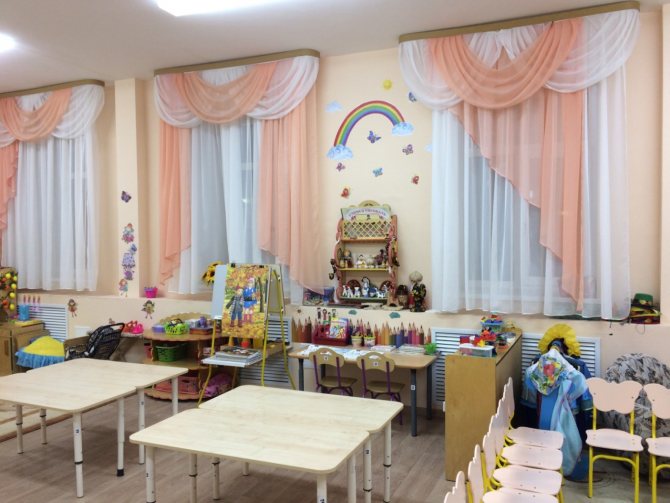
When organizing a developmental subject-spatial environment for children in the group, several options for its construction were used:
1. Zoning of space is carried out using mobile means –
arrangement of furniture and equipment.
2. Use of bedroom premises. 3. One of the main factors determining the possibility of implementing the principle of activity is the creation of a play environment that provides the child with the opportunity to move.
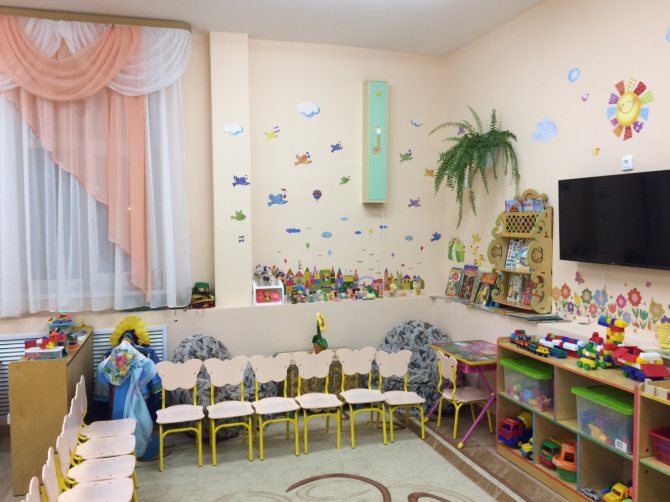
The subject-spatial development environment is organized taking into account the requirements of the Federal State Educational Standard, where all five educational areas are clearly visible:
social-communicative, cognitive, speech, artistic-aesthetic, physical.
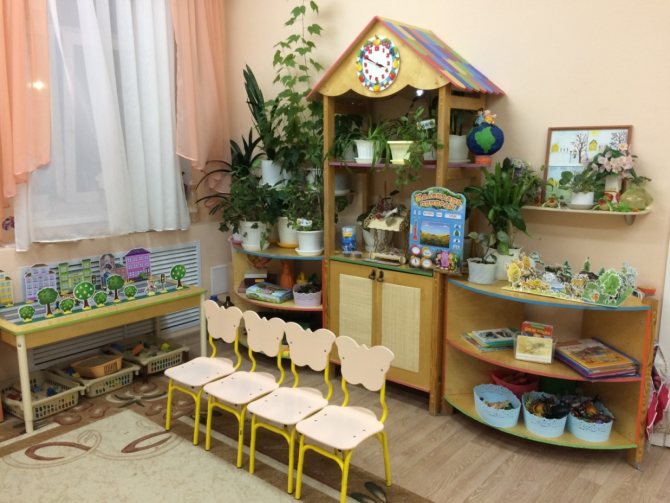
When constructing a subject-spatial developmental environment
The following principles were taken into account:
1. the principle of distance, position during interaction;
2. the principle of activity, independence, creativity;
3. principle of stability, dynamism;
4. principle of integration and flexible zoning;
5. the principle of emotionality of the environment, individual comfort and
the emotional well-being of every child and adult;
6. the principle of combining conventional and extraordinary elements in aesthetic
organization of the environment;
7. principle of openness - closedness;
8. the principle of taking into account gender and age differences in children.
Activity centers are organized based on integration
contents and types
activities in the following areas.
Direction: Artistic and aesthetic development.
IN
For the development of children, various pictures, drawings depicting crafts, design options for products, diagrams depicting the sequence of work for making various crafts, etc. have been selected.
This gives children new ideas for their productive activities, as well as
involves mastering the ability to work according to a model. This center contains materials and equipment for artistic and creative activities: drawing, modeling and applications (paper, cardboard, stencils, paints, brushes, glue, pencils, napkins, scissors, coloring books, clay, plasticine, educational games, etc. ).
If desired, the child can find and use what is necessary to realize his creative ideas, plans, and fantasies. This center has free access.
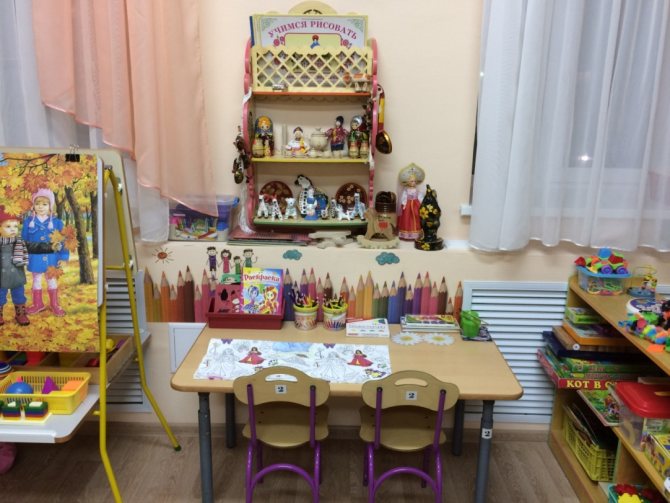
Direction: Speech development.
includes
a book corner. The content of the book corner corresponds to the age characteristics of children of this age and the educational program implemented in the preschool institution. It contains books with works of fiction by children's writers, fairy tales and other literary forms on the topic of the week. The main principle of selecting book publishing products is
minimum text – maximum illustrations. In the book corner there is a photograph of the writer whose work children are currently becoming familiar with and his literary works.

IN
There are various educational games for
speech development, a series of pictures and illustrations to establish the sequence of events, sets of paired pictures for correlation, sectional plot pictures, etc. A speech development environment is a specially organized environment that most effectively influences the development of different aspects of each child’s speech.
Direction: Cognitive development.
The centers are organized and presented taking into account the individual characteristics of children, their sensory experience, information baggage, i.e. theoretical and conceptual awareness of the child. Selected visual didactic material gives children an idea of a holistic picture of the world, the close relationships and interactions of all objects.
includes environmental activities. This center contains various types of indoor plants, on which it is convenient to demonstrate modifications of plant parts, tools for caring for these plants: aprons and sleeves, sticks for loosening, metal children's rakes and shovels, a spray bottle, watering cans, etc. Passports are issued for all plants with symbols. During the cold season, my children and I place an indoor mini-vegetable garden here. In addition to indoor plants, this center contains various educational environmental games, series
paintings such as “Seasons”, “Fauna and Plants”, collections of natural materials, dummies of vegetables and fruits, insects, etc. An important component of a corner of nature is a calendar of nature and weather, a calendar of bird watching. The Ecology Center has a panoramic model of the forest and forest inhabitants in different seasons.
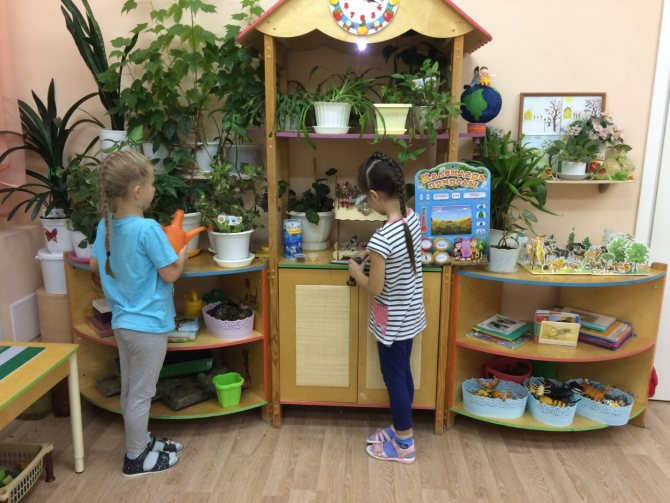
Center for Experimental Activities
is represented by a variety of collections (soil, stones, minerals, seeds, cereals, etc.).
It contains material for carrying out experimental activities: magnifying glasses, microscopes, compasses, beakers, flasks, measuring cups, watering cans, watches, etc. In the process of experimental activities on growing plants, observation diaries are kept in which the teacher records the conclusions made by the children on results of daily observation. Our little “whys” will turn into inquisitive researchers, conduct simple experiments, and determine the properties of various natural materials.
(game library)
has important developmental functions.
In this center there are normative and symbolic materials: a magnetic board, sets of cards for comparing numbers and quantities, sets of cubes with numbers and numerical figures, various types of mosaics and modern puzzles are presented. A fairly wide selection of games to develop fine motor skills. When choosing games, preference was given to the games' ability to stimulate children's development.
Such games are educational games by Voskobovich, “Mongolian Games”, Cuisenaire sticks, Nikitin’s “Cut Square”, “Dienesh Logic Blocks”, etc. Game equipment creates a rich, holistic environment with sufficient space for games.
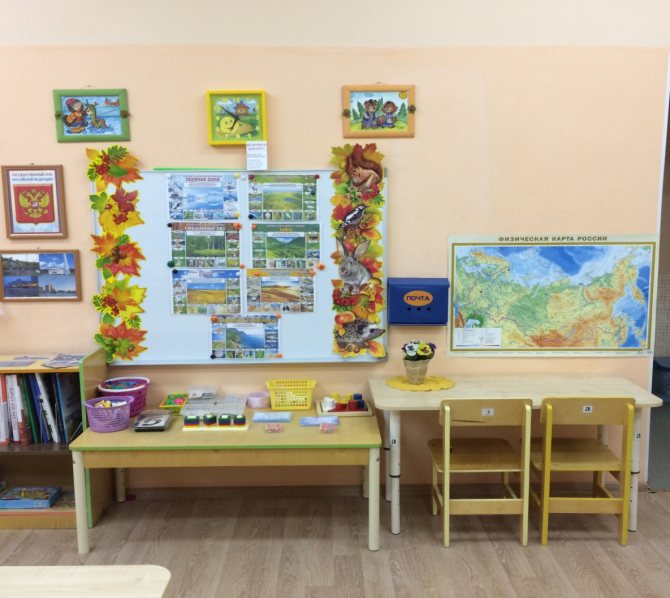
At the “Moral and Patriotic” Center
State symbols of the native city of Zaozersk, the city of Murmansk and Russia are placed. It contains manuals reflecting the multinationality of our Motherland, illustrative material to familiarize children with the climatic zones of Russia, samples of folk arts and crafts, etc. A corner of their native land has been designed, in which children can get acquainted with the traditions, culture and way of life of the inhabitants of the Murmansk region . The corner of the native land includes fiction on local history, the album “My City”, the handwritten book “What could be more valuable than a family”; a toy library has been created: “Symbols of Russia” (coat of arms and flag), “Memo “Moscow””, “Memo. St. Petersburg", "Memo. Paintings by Russian artists”, “Memo. Sights of Russia”, “Wonderful Patterns”, “State Holidays of Russia”, “Russia” (walking game), “Our Motherland” (educational puzzle game);
.
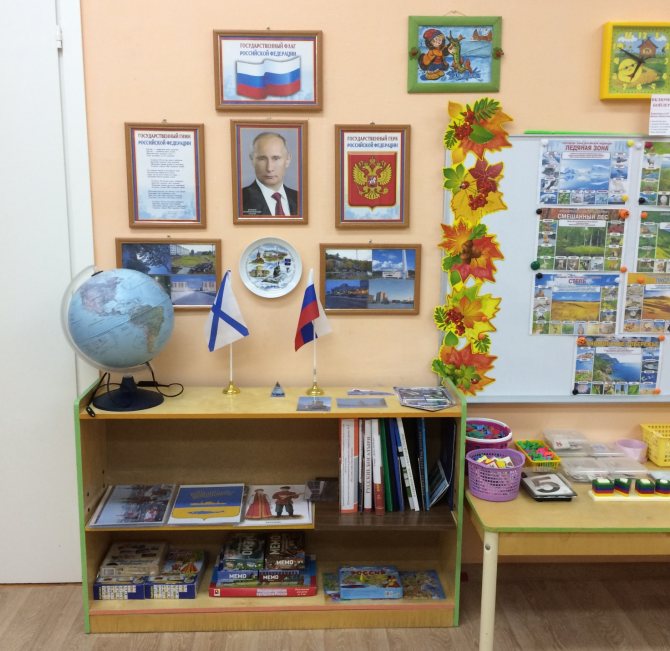
"Construction" (constructive) Center
, although it is concentrated in one place and takes up little space, it is quite mobile. Its practicality lies in the fact that with the contents of the construction corner (various types of construction sets, large and small wooden construction sets), you can move to any place in the group and organize this activity both with a subgroup of children and individually. In the group there is a center for construction games, in which various types and forms of construction sets are presented in a wide variety. Our students independently realize their plans
use diagrams and models of buildings. The center is supplemented with small toys for playing with. The mobility of this center allows children to develop the plot of the game outside of it. This allows our children to feel comfortable in any corner of the group.
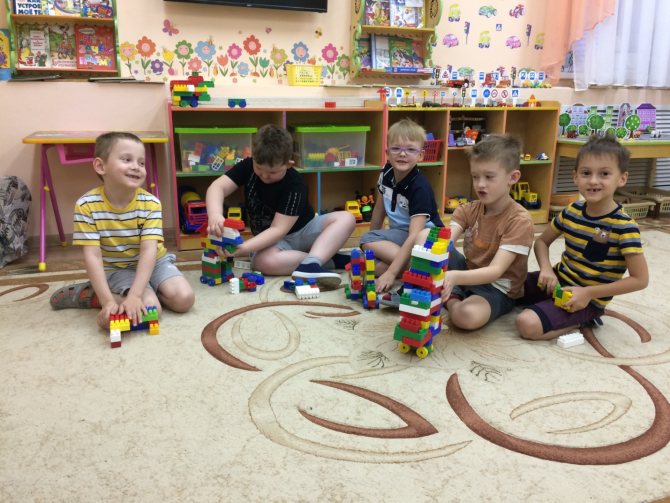
"Musical and theatrical" Center
- this is an important object of the developmental environment, since it is theatrical activities that help to unite the group and unite children with an interesting idea. In the theater, preschoolers open up, demonstrating unexpected facets of their character. Various types of theaters are located here. Children are great artists, so they happily participate in productions and happily act as spectators. It is represented by various types of theaters (puppet, shadow, tabletop, bi-ba-bo, finger).
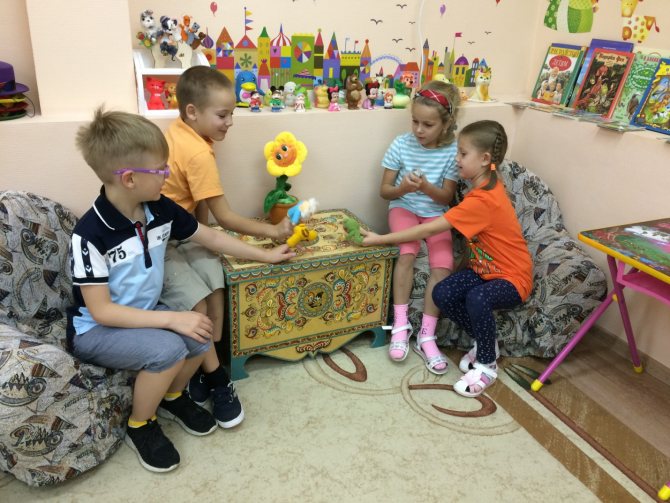
Here there are masks, attributes for acting out fairy tales, elements of costumes for the characters, and the children make their own decorations. The musical development of a child comes down not only to classes with a teacher, but also to the opportunity to play independently, improvise, and play music freely. For this purpose, our group has created a musical one. Which helps my students transfer the experience gained in music classes to others
conditions, helps to establish a sense of self-confidence, activity, and initiative.
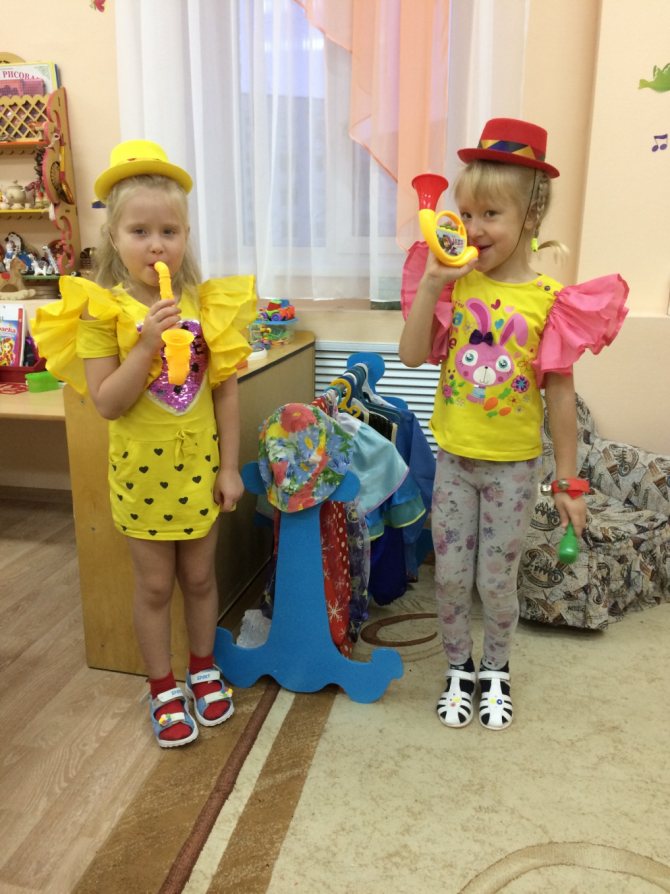
IN
placed - TV, music speaker.
The flash drive is used to play videos, illustrations and presentations on TV, and also as an interactive trainer for individual lessons with children. Also in the center there are children's musical instruments (spoons, rattles, tambourines, drums, etc.), which are used by children in free activities.
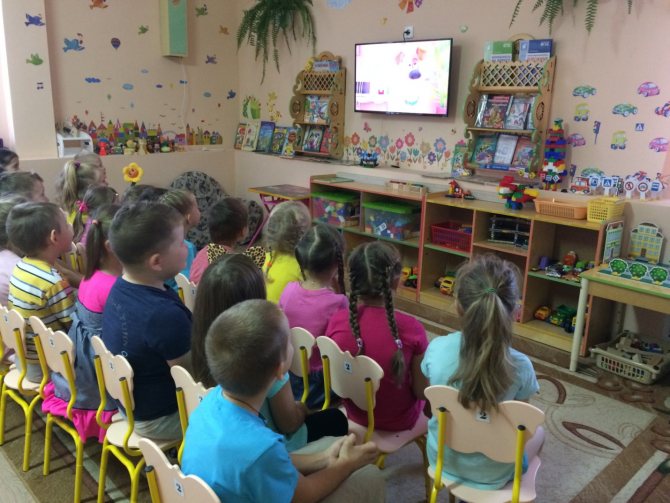
IN
equipment and aids are placed in such a way that children can easily select toys and combine them “to suit their creative play ideas.” Due to the fact that the play plans of older preschoolers are very diverse, all stationary play furniture is used multifunctionally for various role-playing games. The gaming material is placed in boxes with symbols, the children choose the plot of the future game at their own discretion, and transfer the gaming material to a place convenient for them, for free construction of the playing space. Versatile Game Layouts
located in places easily accessible to children. The models are portable (to play on the table, on the floor, in any place convenient for the child). Thematic sets of small character figures are placed in boxes, close to the layouts (so that the universal layout can be easily and quickly “populated”, at the request of the players).
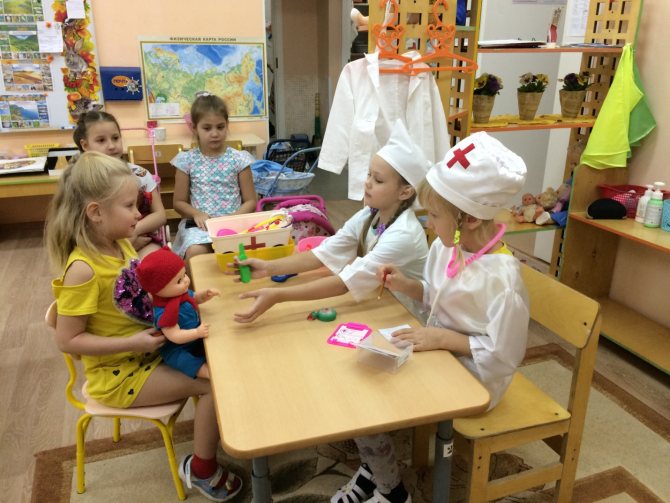
reflects safety at home, on the street (traffic rules) and
fire safety. It is equipped with the necessary attributes, toys, and educational games. A good teaching aid is a specially equipped table with street and road markings, and an additional set of small building materials and road signs. Creating a safety center in a group helps children become familiar with the rules and norms of safe behavior and develop the values of a healthy lifestyle.
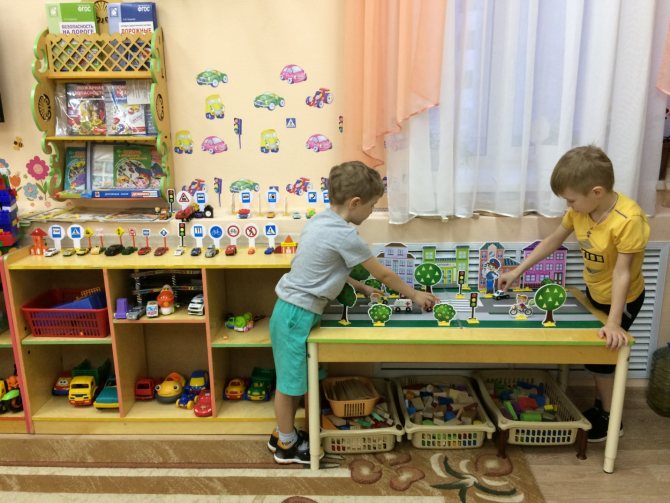
Direction: Physical development.
contains both traditional
physical education equipment, as well as non-traditional (non-standard), made by the hands of teachers and parents. This equipment is aimed at developing the physical qualities of children - agility, accuracy, eye, reaction speed, strength qualities. At the present stage of development, there is a need to place games and manuals in this center to introduce older preschoolers to healthy lifestyle skills. This Center is popular among children because it fulfills their need for physical activity. Increase
physical activity has a beneficial effect on physical and
mental development, health status of children.
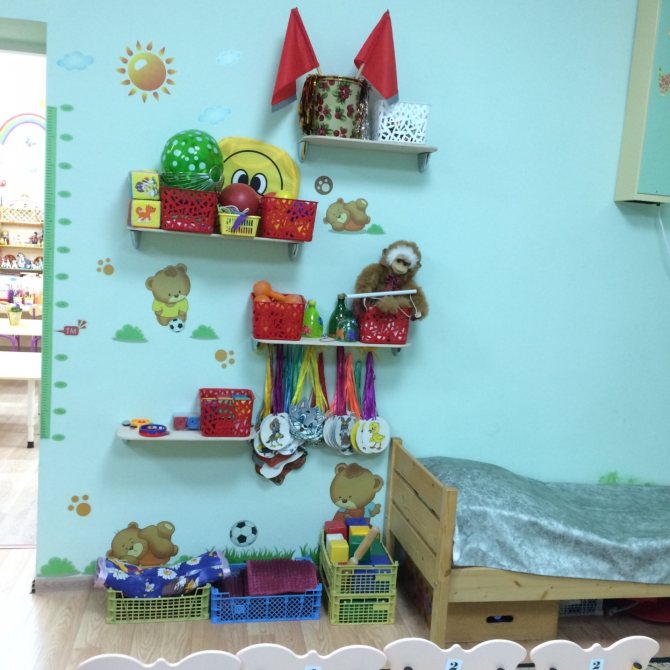
English writer Oscar Wilde said that “The best way to make children good is to make them happy...”. And all our children are good! And by creating a favorable development environment for our children, we want to see them also like this: mastering the basic cultural ways of activity, possessing a positive attitude towards the world, a developed imagination, able to express their thoughts, curious, resilient and physically developed, and most importantly, happy! The advantage of the created environment is that it is possible to involve all children in active independent activities. Each child chooses an activity of interest in any center, which is ensured by a variety of subject content, accessibility and ease of placement of materials. It was noted that pupils have less conflict with each other: they rarely quarrel over games, play space or materials, because they are passionate about interesting activities. The positive emotional attitude of our children testifies to their cheerfulness, openness, and desire to attend kindergarten.
The search for innovative approaches to organizing a subject-development environment continues, the main criteria being creativity, talent and imagination.
October 28, 2019
14
Corners and centers in groups - Corner of patriotic education in the preparatory group
Publication “Corner of Patriotic Education in Preparatory School...”
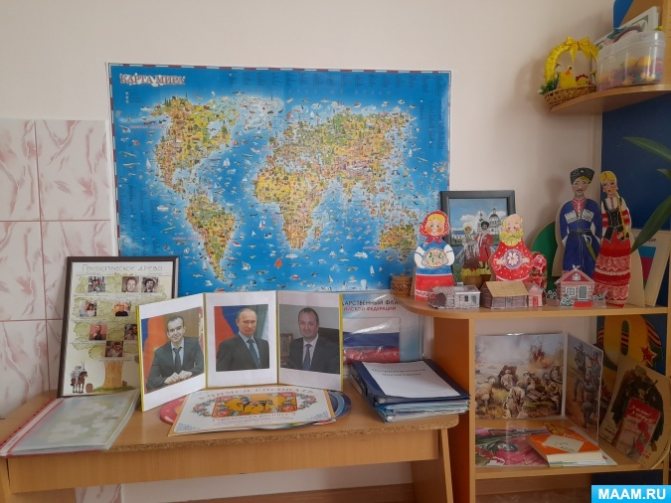
Patriotic education in the preparatory group. For a more in-depth study of the patriotic education of preschoolers in the preparatory group, a patriotic corner was created. Patriotic education is the cultivation of love for the Motherland, devotion to it, responsibility...
Traffic rules corner in the preparatory group
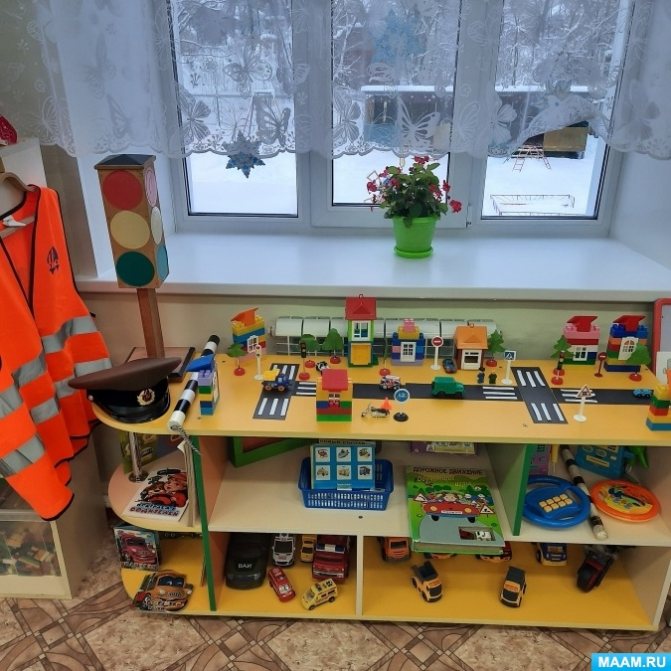
The issue of child safety on city streets is becoming increasingly relevant in modern life. The study of traffic rules is an integral part of the educational and educational work of kindergartens. To protect your child from danger, you need to prepare him as early as possible for a meeting with...
Ecological centers in accordance with the requirements of the Federal State Educational Standard for senior and preparatory groups. In accordance with the Federal State Educational Standard and the general educational program of a preschool educational institution, a developing subject-spatial environment is created by teachers to develop the individuality of each child, taking into account his abilities, level of activity and interests. For execution…
Notes for the lesson "Travel to a Magic Corner" for children of senior preschool age with special needs. Notes for the lesson "Travel to a Magic Corner." Goal: to form new sensory experiences in children using sensory integration methods. Objectives: Correctional and educational: continue to familiarize children with the senses and their functions. Correctional and developmental: develop...
Preparatory group. Senior preschool age. Children 6-7 years old
Summary of the lesson “Trip to the Cosmonaut Training Center” in the preparatory group Summary of the lesson on the topic “Space”
in the preparatory
group Journey to the Center of Cosmonautics .
Goal: Expand children's understanding of space; promote the development of children's cognitive and intellectual abilities. Objectives: to contribute to the expansion and deepening of ideas... Theatrical corner “Theater of Fairy Tales” in the preparatory group
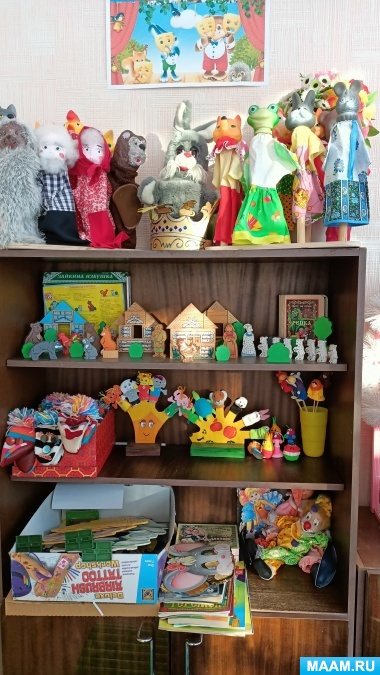
Theater is a magical world. He gives lessons in beauty, morality, and ethics. And the richer they are, the more successful the development of the spiritual world of children is. B. M. Teplov. Theater is one of the most accessible forms of art for children. Preschoolers love to watch theatrical performances...
Game "What does it look like"
Target. Bring children to the realization that objects of the man-made world are created in the likeness of objects of nature, and elements that do not exist in nature were invented by man himself.
Material. Pictures depicting objects of the man-made and natural world (a lamp in the shape of a bell, a musical bell, a bell flower; a matryoshka doll, an electric lamp, a pear, etc.) (for each child).
Progress of the game
Each child is offered a set of pictures depicting objects of the man-made world and one picture depicting an object of nature. At the teacher’s command, children must select images of objects of the man-made world, similar to the natural object shown in the picture.
The winner is the one who selects the corresponding pictures first and proves that he is right.
Game "Past and Present"
Target. To develop children’s ability to navigate in the past and present of objects.
Material. Ball.
Progress of the game
Children stand in a circle. The presenter names an object from the past and throws the ball to one of the players. The one who caught the ball names the object in the present tense, for example: broom - vacuum cleaner; abacus – calculator; typewriter - computer; sundial - mechanical watch.
Game "Be careful!"
Target. Encourage children to compare objects according to how they are used.
Material. Object pictures, pencils, sheet of paper.
Progress of the game
Each player receives a card that depicts an object from the man-made world. It determines the way a given item works and draws the item with the opposite way of use.
For example: refrigerator - electric stove, chair - bus, steamboat - balloon, fur coat - fan, bed - alarm clock, fur coat - fan, scissors - needle or glue.
Game “Tell about the material”
Target. To consolidate children’s ideas about materials (types of fabric, paper; artificial and natural materials) from which objects are made.
Material. A cube with different materials depicted on its faces.
Progress of the game
Children take turns tossing the cube.
The cube is lowered with some face onto the surface of the table, the child names the material that fell out to him and describes it. Other players control the correctness of the description of the properties and qualities of the material.
Game "Magic words"
Target. To form ideas about the polysemy of names of objects of the man-made world.
Progress of the game
The teacher invites the children to play with magic words. He tells that there are magic words that are similar in sound but different in meaning, and asks to name such words. If the children find it difficult to start the game, the teacher helps them.
Words: mouse (animal and computer element), key (lock and spring), caterpillar (insect and part of a tractor), lightning (natural phenomenon and fastener), bow (vegetable and weapon), handle (door and part of the human body), bat (animal and sleeve model); zebra (animal and pedestrian crossing); ruff (fish and kitchen utensils); needle (pine and sewing); shark (fish and helicopter model); mites (insects and tools); bananas (an exotic fruit and a trouser model), a sponge (a sea plant and a personal hygiene item), etc.
Game "Collect an object"
Target. Encourage children to search for missing parts; to form an understanding that the absence of any part makes it impossible to use the item.
Material. Pictures depicting objects of the man-made world with missing details and pictures depicting these details.
Progress of the game
Each child receives a picture of an object with a missing part. Pictures depicting parts are laid out on the table.
At the teacher’s signal, each child finds the missing part and completes the object with it. The first one to find all the missing parts wins.
Game “Wonderful Things of the Man-Made World”
Target. Help children realize that man has created diverse forms of objects that make them easier to use; encourage finding objects of different shapes with one way of use.
Material. Pictures depicting man-made objects of different shapes with one way of use.
Progress of the game
Children are divided into 2-3 teams. At the teacher’s signal, the participants of each team select pictures that depict objects for the same purpose, for example, for cooking, cleaning an apartment, working in the garden, etc. The game is considered over when the teams complete the task.
Making the game more difficult. Select pictures depicting objects that satisfy different human needs. For example, scissors are needed for cutting paper, trimming flowers, cutting nails, hair, etc.
